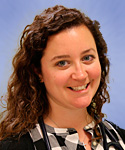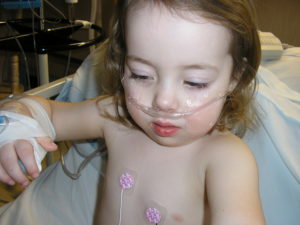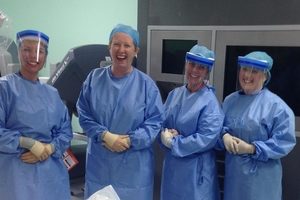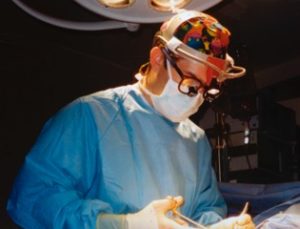September 1st, 2017
Obesity Counseling: Getting Real
Emily F. Moore, RN, MSN, CPNP-PC, CCRN

Emily F. Moore, RN, MSN, CPNP-PC, CCRN practices pediatric cardiovascular care across the Pacific Northwest.
“Your BMI puts you in the obese category. You need to limit weight gain to 10 pounds this pregnancy.”
As the obstetrician’s words sunk in, I was overcome with embarrassment. Sure, I knew I was overweight, but I was pregnant. And according to my BMI, I have been “obese” for years. But this was the first time a provider had actually called it to my attention, at least in such a blunt manner.
Sitting in the patient’s seat made me think about the best way to counsel families of pediatric patients about obesity. I have had plenty of practice discussing diets with people, but now I wondered — was I being sensitive to people’s feelings while also making the necessary lasting impression? The first time I had to educate a family regarding obesity, it wasn’t fun, but my preceptor broke the ice. Here’s what happened:
I had a patient in the 99th percentile for weight and BMI. He was only 7 and visibly obese. My preceptor counseled me before the appointment, educating me on why this was an important issue and how it would affect his life for years to come. He couldn’t stress enough how the family needed a provider to be “real” with them. I walked into the patient room and politely started asking about diet and exercise. After about 5 to 10 minutes of dancing around the subject, my preceptor barged into the room and said, “What she’s trying to say is, your son is overweight.” Though his approach was abrupt, it got the point across and got us all down to business. My preceptor asked me to show the family my patient’s growth charts and really explain, without beating around the bush, how serious the subject was. So, there I sat, showing charts and talking about the importance of exercise as well as avoiding juice, candy, soda, and the like. My patient left with a plan to change his diet and follow up in a few months.
 My clinical training took place in an area where not every neighborhood is safe, and many of my patients were of low socioeconomic status. This complicated things when counseling them about diet and exercise. How does one encourage physical activity when there is no safe place to play? Similarly, with money scarcity, buying fresh fruits and vegetables in lieu of fast food was not always possible or a priority, especially in families where parents were working two jobs just to make ends meet. In these situations, a parent would often tell me that time and money were pretty influential in guiding meal choices. A box of macaroni and cheese is not only much cheaper but can feed a lot more people than a head of lettuce.
My clinical training took place in an area where not every neighborhood is safe, and many of my patients were of low socioeconomic status. This complicated things when counseling them about diet and exercise. How does one encourage physical activity when there is no safe place to play? Similarly, with money scarcity, buying fresh fruits and vegetables in lieu of fast food was not always possible or a priority, especially in families where parents were working two jobs just to make ends meet. In these situations, a parent would often tell me that time and money were pretty influential in guiding meal choices. A box of macaroni and cheese is not only much cheaper but can feed a lot more people than a head of lettuce.
Hearing this story over and over again, I began to realize that although clinicians can do a lot to educate parents regarding childhood obesity and promote healthy eating, we must first understand the context of our patients’ lives — neighborhood safety, access to healthy foods, income level — to be most effective. By validating these hardships prior to suggesting solutions, I found that families were much more receptive to change.
 After being on the receiving end of obesity counseling, I started to suggest rules for my patients’ families to follow. I picked up several of these from a physician I shadowed for a number of months, and now I use them all the time (in my home as well). Here they are:
After being on the receiving end of obesity counseling, I started to suggest rules for my patients’ families to follow. I picked up several of these from a physician I shadowed for a number of months, and now I use them all the time (in my home as well). Here they are:
- First and foremost, diet and lifestyle changes need to happen now.
- Always eat breakfast, and make sure this meal has protein in it, as some evidence shows that people who eat breakfast with protein eat fewer calories throughout the day. (I have personally found this to be true.)
- No juice, soda, or other drinks high in sugar
- And lastly, try not to eat in front of the television. If you are hungry, sit at the table or assigned family eating place and eat without distractions. This will hopefully keep you from consuming food mindlessly past the point of satiation.
In regard to my last pregnancy, I am proud to say that I only gained 12 pounds and gave birth to a 9+ pound baby! I made exercising a priority and followed a healthy eating plan. It was much easier to lose the weight after already having these practices in place. Was it fun? Not really; there were definitely days when I struggled. But I did it, and I am thankful for my provider’s transparency.
August 24th, 2017
How to Land Your Dream PA or NP Job While You’re Still in School
Megan Tetlow, PA-C

Megan Tetlow, PA-C, is from Fort Myers, Florida, now working in Sheffield, England, as part of the National Physician Associate Expansion Program. She practices in gynecologic oncology and is a guest blogger for In Practice.
I have the pleasure of working with multiple PA students, both as a clinical preceptor and through teaching at the university. I’ve found myself fielding the “how do I find a job?” question a lot recently, so I thought I would address it here.
I think the best way to find a job as a PA or NP is while you are still a student. Finding a job through your rotations gives you the chance to get a real working sense of what being a PA or NP on a particular team might be like and lets you get familiar with your future team members. I was privileged to find my first job as a PA on my elective rotation, and it worked out well for me.
So, if you are a PA or NP student and are looking to secure a job while on your rotations, read on for my advice…
Treat every day like a job interview.
If I could impart one piece of wisdom to PA and NP students, it would be this: Treat every day you are on rotation like a job interview. Because it is one. Whether you treat it as such or not. Every rotation. Every interaction even. And it is your own actions, preparedness, and motivation that make getting a job either a very real possibility or a remote one. Would you turn up 15 minutes late for a job interview? Hopefully not. Would you prepare ahead of time and ask engaging questions? Hopefully yes. While on your rotations, ask yourself, “Would I do [such and such] if I were on a job interview?” The answer might just mean the difference in getting you a real job.
The best job may be the one you create yourself.
So the rotation you’re on doesn’t have an advertised listing for a PA job? Great. According to Forbes, half of all jobs are unadvertised. Perhaps the group you’re rotating with has never considered having a PA or NP on their team, but when they get a stellar student (ahem — like you), they start thinking that adding one might be just what the service needs. Perhaps they’ve seriously considered adding an additional provider to their group and are just waiting for the perfect candidate. Regardless of the reason, the lack of an advertisement online does not mean lack of a possible position. And don’t be afraid to gently field the question, “Has your group ever considered hiring an additional PA?” You might be surprised by the answer you get.
If you’re on a rotation you like, shout it from the rooftops.
If you’ve found an area while on rotation that you love, congratulations. Now, tell people about it. Both officially with your clinical preceptor and the practice/business manager, and also anytime it might come up in conversation with nurses, theatre staff, other providers, etc. We all talk. And word travels fast.
If you’re on a rotation you don’t like, keep it to yourself.
For the same reason as above. I’m an ob/gyn PA. Students tend to either love it or hate it. We get it. But you should assume that those of us in the field do like it and probably don’t want to hear you speak negatively about it. Consider it the professional version of “If you can’t say anything nice, don’t say anything at all.” Dislike often comes off as disinterest — and no one is going to go out of their way to help out a student who appears disengaged.
If you’ve had a clinical preceptor who invested time and energy in teaching you how to be a good provider, thank them! Call me old-fashioned, but I’m a stickler for a handwritten thank-you note. Emails work too. Saying thank you leaves a good impression. It also helps you stand out in your preceptor’s mind should an opportunity present itself later, or if they are asked for their impressions of you for a role you’re considering later (like I said before, we all talk).
Good luck out there. Now go get ‘em!
August 17th, 2017
Primary Care’s Got Talent
Elizabeth Donahue, RN, MSN, NP-C
There is one hour each day in the office that I refer to as the “golden hour” – from 6:30 to 7:30, either AM or PM. For the sake of my personal life, most days I aim to be at my desk for one of those two slots but not both. During this time, I’m usually alone in the office and I find myself being uber productive; tackling notes and other tasks without distraction.
Last Thursday night, after all the patients and staff had gone, a colleague and I sat at our desks, listening to Dave Matthews Band and charting/chatting away. We got onto the topic of a certain tooth straightening system that rhymes with “shmin-vizza-line” and how we were both considering treatment. We wanted to know where we could see experienced providers for treatment in Boston, so we searched the brand’s website. To our surprise, the providers vetted by the company were ranked in a five-tier system from “preferred” all the way up to “top 1%.” And because I love to ask inane questions that make others go ‘hmmmm,’ I began a quest to pester my coworkers into answering this question: What do you do that would rank you in the top 1% among primary care providers?
 For me, the answer came easily — if my office voted for “pap queen” instead of “prom queen,” I feel I could run uncontested. In fairness, I see a lot of young, female patients, I am a stickler for preventive care, and I’ve covered years of “pap only” visits for male physician colleagues. Therefore, some of this bravado is a direct result of quantity. But still, I maintain that I have a gift for finding a cervix — it can run, it can hide, but I will find it. On one occasion, I even found two instead of one! A septate uterus with bilateral cervices… if that doesn’t qualify for top 1%, I’m not sure what does.
For me, the answer came easily — if my office voted for “pap queen” instead of “prom queen,” I feel I could run uncontested. In fairness, I see a lot of young, female patients, I am a stickler for preventive care, and I’ve covered years of “pap only” visits for male physician colleagues. Therefore, some of this bravado is a direct result of quantity. But still, I maintain that I have a gift for finding a cervix — it can run, it can hide, but I will find it. On one occasion, I even found two instead of one! A septate uterus with bilateral cervices… if that doesn’t qualify for top 1%, I’m not sure what does.
My pharmacy colleague suggested she might fall in the top percentile when it came to insulin management and diabetes control. She is a CDE and a self-proclaimed “type A personality,” so the numbers game of diabetes is where she excels. My NP teammate in the office shared her expertise and confidence in treating chronic pain; she had spent months shadowing specialists, studying guidelines (on cross titration, non-opioid management strategies, etc). In her words, she took something that primary care did not train her well for and “figured it out,” so now rather than being “scared of it,” she can do it well. When I asked my evening charting buddy what she excelled at, she sighed deeply and told me that her special talent was “making my patients cry.” (She has found, sometimes to her chagrin, that she has a way of letting patients open up.) A male physician colleague, always the jokester, responded immediately, “I inhibit that response, that’s my talent!” (An open-concept team room makes for frequent group conversations, but that’s a blog for another day.)
 Finally, one very seasoned colleague, who I’ll call Bob, new to primary care but with years of experience in emergency and hospital medicine, patently refused to answer the question. “I’m so new (to primary care),” he said. “I don’t think anything I do is in the top 1%,” he said. “I’m never answering that question. Forget about it.” Finally, under protest, he gave his answer — that maybe (just maybe) his talent across his years of practice was connecting with the patient quickly and “making them feel like I give a damn.” In response, I told him I might award him the “top 1% in humility.” He laughed sheepishly. I just love that Bob.
Finally, one very seasoned colleague, who I’ll call Bob, new to primary care but with years of experience in emergency and hospital medicine, patently refused to answer the question. “I’m so new (to primary care),” he said. “I don’t think anything I do is in the top 1%,” he said. “I’m never answering that question. Forget about it.” Finally, under protest, he gave his answer — that maybe (just maybe) his talent across his years of practice was connecting with the patient quickly and “making them feel like I give a damn.” In response, I told him I might award him the “top 1% in humility.” He laughed sheepishly. I just love that Bob.
This initially lighthearted question led to a deeper conversation among my colleagues that uncovers for me a few of the beautiful things about primary care. First, you can find a different problem to manage each day behind each exam room door. Also, as a provider, you can choose to hone specific skills — those that interest you, or which demand or trends might dictate — or you can bring a gift that comes naturally to you to each patient you see. And in a team-based care environment, we have the ability to rely on one another’s gifts and talents. To adapt the old adage, “jack of all trades, master of none” to suit my point, I’d suggest that my talented colleagues in primary care are jacks of many trades, masters of some (they just need to be asked which ones … unless you ask Bob, because he’s still not fessing up!)
P.S. Names have been changed or withheld to protect the innocent subjects of my extracurricular pursuits.
August 9th, 2017
Curing the Culture — A Gentle Nudge
Harrison Reed, PA-C
You and I have covered a lot of ground this year.
We exposed the fallout of a toxic workplace culture and discussed some of the first steps we can take to fix it. We reestablished respect for our patients. We adjusted some of the biggest problems with our sign-out process. We reminded ourselves of the power of the letter of condolence. And, just for fun, we resolved to lose some of our wordy weight.
All the while, however, we have danced around a more central truth: much of the emotional and psychological damage we accrue in the workplace is inflicted by other healthcare workers. In a field that already struggles against the laws of physics and biology, we complicate our mission with the additional burden of interpersonal conflict. Like the illnesses of so many of our patients, that affliction is preventable.
It’s easy to ignore the problem; denial becomes a refuge. But once we take full responsibility for the toxic behavior in our environment, we can work toward a solution. It will take hundreds of small acts—performed by hundreds of thousands of people—to help nudge our culture in the right direction. Here are a few to get us started:
Mind your manners
I hate to say it, but our parents were right. Manners matter.
Polite society can vanish within the walls of a hospital. We place phone calls without introducing ourselves. We abolish “please” and “thank you” (or mutter it like a curse). We would rather attack than apologize. We act like jerks.
If you want to test just how alien even basic pleasantries are in healthcare, do this: the next time someone from another team or service calls you, ask them how their day is going. That tiny gesture surprises the people I talk to so much that they often stumble over their responses.
A friendly comment can declare a cease-fire when tensions run high or can pick someone up when they are pummeled by stress. It reminds everyone in the room of a simple truth: we are all human.
There is nothing worse than the combination of disorientation and isolation that comes from plunging into an unfamiliar environment. And to make matters worse, workplace culture often punishes new employees with additional social penalties or outright hazing.
Even after new employees pay their dues and are welcomed into the fold, it is hard to forget a rocky path to acceptance. Resentment can linger and undermine team cohesion for years. Unfortunately, many of those who experience hazing later replicate the same behavior when the next generation of colleagues joins the workforce.
Someone has to break the cycle. When new employees show up, ensure they feel welcome and included. Establish a clear, positive culture with new recruits from day one—a culture that has no tolerance for abuse.
End tribalism
It feels great to be part of a cohesive team. And one of the surest ways to bring a group together is to focus on a common goal—or a common enemy. Unfortunately, that shortcut to team unity breeds an unpleasant byproduct: rivalry. In healthcare, it’s all too easy to draw lines between “us” and “them.” We form packs based on a variety of criteria: our professions (“doctors vs. nurses”), our specialties (“medicine vs. surgery”), and our institutions (“Everyone vs. Us”).
But, with rare exceptions, we don’t practice medicine in silos. Healthcare is far too complex, far too diverse, and far too interdependent to avoid working with people from other “tribes.” Casting aside these arbitrary differences erases a major barrier to teamwork.
Call it when you see it
Most who work in healthcare, at their core, are great people. But we all need an occasional reminder to clean up our acts when our behavior falls below the standards of our principles. A healthy organization should create mechanisms to call out toxic behavior. Some teams—those with a deep sense of trust and respect—can do this in situ and head off an incident before it escalates. But there should also be a formal pathway to highlight and discuss incidents confidentially after the heat of the moment has passed.
There will always be outliers, individuals who spew toxicity on a regular basis despite warnings. Administrations should lay out clear consequences for repeat offenders—and enforce them as needed. But for most, a gentle reminder is all it takes to keep us all focused on the same goal: helping patients and supporting each other.
August 3rd, 2017
“As I Lay Dying” — Patient Readmission and Non-Compliance
Alexandra Godfrey, BSc PT, MS PA-C
As I tie the last knot in a neat row of nine sutures, the night nurse calls me to room two. I drop my hemostats, peel off my gloves, and tell my patient I will be back. Across the hall, I find a girl thrashing around the gurney, chest heaving up and down, hands clasped around her abdomen. She stops moving only to retch into a bag. Her gasping breaths smell of pear drops, nail polish, and sugar candy. The ER attending is soon by my side. We know this girl. She presents this way every one to two months. I give her a nod of recognition, then start looking for IV access. Later, the labs confirm our clinical suspicion; she is in severe diabetic ketoacidosis (DKA).
 When I review this patient’s records, I count seventeen admissions (to various facilities) for DKA in the past two years. Her HbA1c averages 14. Each time, the patient is admitted to ICU, treated and stabilized, then discharged with a plan for follow-up. Prior to discharge, the patient receives education regarding the management of diabetes, a consultation with a dietitian, a referral to a specialist clinic, and resources to aid her with her healthcare. Both psychiatry and social work have evaluated this patient. In spite of this, the patient continues to miss appointments, fails to refill her meds, and pays little attention to important factors, such as diet, exercise, and glucose control. Reasons for non-compliance, include: I am tired of being sick, insulin makes me fat, my boyfriend stole my meds, and I don’t like doctors.
When I review this patient’s records, I count seventeen admissions (to various facilities) for DKA in the past two years. Her HbA1c averages 14. Each time, the patient is admitted to ICU, treated and stabilized, then discharged with a plan for follow-up. Prior to discharge, the patient receives education regarding the management of diabetes, a consultation with a dietitian, a referral to a specialist clinic, and resources to aid her with her healthcare. Both psychiatry and social work have evaluated this patient. In spite of this, the patient continues to miss appointments, fails to refill her meds, and pays little attention to important factors, such as diet, exercise, and glucose control. Reasons for non-compliance, include: I am tired of being sick, insulin makes me fat, my boyfriend stole my meds, and I don’t like doctors.
The patient’s recurrent admissions have resulted in job loss, relationship breakdown and economic stress. The patient is stabilized during every admission, but she never appears to retain any of the education or advice given to her. Or if she does, she pays little attention to it. Control of her diabetes worsens. She lives crisis to crisis.
Truth is, she is not alone. Most emergency medicine providers have encountered patients like this, as have most of the broader medical community.
Let’s face it — the thoughts, actions, and motives of our patients frequently don’t make sense to us. And every human has a thought process that tumbles with varying levels of rationality, sometimes intentional and other times unintentional. Delusions and rationalizations along with a layer of narcissism and a sad tendency for self-destruction are part of the human narrative. But for the most part we don’t dance with death. Certainly, our patient’s narrative may sometimes seem irrational, but as clinicians we need to find ways — must find ways — to work around it.
Way back, Flexner et al in their article, “Repeated Hospitalizations for Diabetic Ketoacidosis: The Game of Sartoris” compared such patients to Faulkner’s Sartoris family. The Sartoris family appears hell bent on self-destruction. After the loss of a beloved son and brother in World War I, the family lives life on the edge and suffers for it. Their lives spiral out of control and the only resolution seems to be death, which inevitably comes. The authors liken the behaviors of this family to those of patients with recurrent admissions for DKA. They suggest that these patients – with theoretically manageable diseases – are, like Faulkner’s family, hellbent on a not-so-glamorous death. I am unsure whether these patients are truly hell-bent on death but I found the idea thought-provoking.
Recurrent admission for the same diagnosis is a serious problem for patients, providers, and healthcare systems. Non-compliance with medications and failure to follow up is associated with greater mortality and morbidity. The long-term complications of poorly controlled diabetes are devastating. We don’t want this for our patients. It contradicts the basic tenets of medicine, what we are about. Additionally, patients who are repeatedly readmitted consume a disproportionate amount of health care resources. Readmissions create problems with reimbursement. Furthermore, physicians and other healthcare providers struggle to manage these patients: they consume more time and resources, appear to not care about their health, and can trigger both frustration and compassion fatigue. The hard part, it seems, is not the management of the crisis but the prevention of future crises.
If we look at this problem logically, we can identify some manageable factors associated with patient non-compliance and readmission:
• Poor patient understanding of the disease or treatment
• Inadequate follow-up or confusion about follow-up
• Comorbidities such as substance abuse and psychiatric diagnoses
• Financial difficulties
• Lack of insurance
• Premature discharge
• Lack of discussion about care goals
• Low health literacy
I like to believe that there are ways we can improve the health of these patients. I do not think we have to resign ourselves to the fictional games of Faulkner. Undoubtedly, I have my own thoughts on how we do this. But I would prefer to hear the perspectives of my esteemed colleagues in the wider medical community rather than focus on my own narrative. So —
1) What can we do to prevent these readmissions?
2) How do you establish an effective care partnership with these patients?
July 26th, 2017
When a Child Receives Care at a non-Children’s Hospital
Emily F. Moore, RN, MSN, CPNP-PC, CCRN

Emily F. Moore, RN, MSN, CPNP-PC, CCRN practices pediatric cardiovascular care across the Pacific Northwest.
In a recent post, I wrote about my niece’s episode of appendicitis. Another part of that story relates to her post-op course. When my sister first called asking my advice on whether or not her daughter needed to be treated, I didn’t specify where she should take her. She ended up going to a general hospital with a pediatrics unit. There, my niece was treated by surgeons and other clinicians who primarily see adults. Here’s what happened.
Less than 24 hours after surgery, I arrived at the hospital to find her slumped over in bed with visible retractions and oxygen saturations around 88%. When I asked about pulmonary toileting and basic nursing care, such as ambulation, positioning, and rolling over in bed, I was told, “We aren’t bullies; we don’t make our kids do that.” When I asked how making a child deep-breathe and walk to prevent nosocomial complications like pneumonia was bullying, I was dismissed. Never one to let things lie, I kept asking questions, and I soon concluded that the institution itself was not familiar with basic pediatric care. Despite being only 8 years old, my niece still needed to sit up, walk, and use an incentive spirometer. (And since when is an oxygen saturation of 88% okay for anyone, assuming there are no signs of cardiopulmonary disease?)
My niece spent close to a week in the hospital and was sent home despite my sister’s concerns regarding things “just being off.” When my sister told the staff that she didn’t think my niece was eating well, she was reassured that this was normal and that discharge was the next step. At home, things continued to worsen, and two days later they returned to the emergency department for continued abdominal pain, diarrhea, and low-grade fevers. Once again, my sister’s concerns were dismissed, and after urine was dipped and “clear,” she was sent home, after being told that my niece was recovering and everything was okay. I was quite surprised that in the setting of postoperative pain and fever, an abdominal imaging was not done and labs were not sent. Two days later, my niece’s symptoms worsened, and I advised my sister to go to a children’s hospital.
Initially annoyed at me for suggesting another institution, my sister immediately saw why she needed to be there. From the animals on the walls to the different colors on the floor, it was clear to her the moment she walked in the door that the care would be more geared towards children. And from the moment they saw a physician, there was no question that the expertise had shifted from an adult provider who sees children to a pediatrics-focused specialist. When my sister first explained the course of events, she was listened to. The physician said, ‘I am sorry this has happened to you; not only is your daughter’s care our concern, but your comfort with her care is as well.” My sister was instantly put at ease and felt that they were in good hands. She thanked me for insisting that they drive the extra miles for my niece to be treated there.
My niece was diagnosed to have three bowel abscesses and a bowel fistula. She ended up being started on total parenteral nutrition and was hospitalized for an additional nine days. Her care team made sure that both my niece and my sister were ready when it came time to go home. Thankfully, this story has ended well for my niece, who is now active and healthy again.
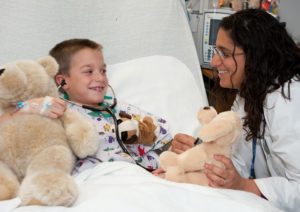 Working at a children’s hospital myself, I sometimes forget how different the worlds of pediatric and adult health care can be. I often go out into the community to educate first responders about pediatric heart disease, and I have realized that while treating kids is normal for me, many of them are uncomfortable with it. (The opposite is true for me… give me a kid any day! Adult-sized patients make me incredibly nervous and uncomfortable.) Also, as demonstrated in this case, a common theme in pediatrics is to treat the family, not just the patient. If a parent has a concern about his or her child, it is addressed. So, when this doesn’t happen in a clinical care setting, I am often surprised and taken aback. I strongly believe that parents know their children best. From my perspective as a pediatric care provider, if you are telling me that your child isn’t back to normal and just seems off, then we should probably take a step back and reevaluate the situation.
Working at a children’s hospital myself, I sometimes forget how different the worlds of pediatric and adult health care can be. I often go out into the community to educate first responders about pediatric heart disease, and I have realized that while treating kids is normal for me, many of them are uncomfortable with it. (The opposite is true for me… give me a kid any day! Adult-sized patients make me incredibly nervous and uncomfortable.) Also, as demonstrated in this case, a common theme in pediatrics is to treat the family, not just the patient. If a parent has a concern about his or her child, it is addressed. So, when this doesn’t happen in a clinical care setting, I am often surprised and taken aback. I strongly believe that parents know their children best. From my perspective as a pediatric care provider, if you are telling me that your child isn’t back to normal and just seems off, then we should probably take a step back and reevaluate the situation.
My niece’s limited care was likely related to the institution’s focus on adults rather than pediatrics. I know that there are many general hospitals with above-average pediatric units. However, this whole situation made me think, should there be more standard practices in place to ensure that children are well cared for everywhere? Should pediatric hospitalists be present at general hospitals? Or should more pediatrics training be conducted at these hospitals? Presumably more trainings and simulations would help ensure a high quality of care for children regardless of where they receive it.
July 20th, 2017
Needing a Vacation after your Vacation? Primary Care Providers Feel the Same!
Elizabeth Donahue, RN, MSN, NP-C
I just finished a week of vacation and, truth be told, I’m seated at a bar on this particular Sunday night seriously considering early retirement. Small problem being, at the tender age of 34, it’s probably a little too soon for this to be a feasible option. I’m trying to figure out how to make retirement work because I’m seated at this bar because of its excellent internet connectivity and not because of the attractive cocktail list. I have a salad and a glass of water and my laptop before me. I’m checking messages, prescription requests, and lab results from the last week — preparing to return to work tomorrow, hoping to reduce the to-do list before I’m physically back in action and actively adding to it.
I know that I’m not alone in this experience. A physician colleague returned from her own vacation about two weeks ago and since we she was in Europe (where she was less able to dock in remotely), she was completely overwhelmed on her first day back in the office. A full clinic day scheduled, with the backlog of messages and requests, and just one really sick patient to manage can leave even the most competent and experienced provider flummoxed. And all of this occurs despite having in-office coverage by a colleague for “urgent” requests and likely several hours of advance work put in by the provider in the week before vacation. It’s leading me to be a little more inquisitive about vacation practices in healthcare settings.
How much vacation do most providers take? Are there specialties that find it easier to take a vacation than others (perhaps some that have less continuity of care burden)? What is the impact of all of the technology we have in 2017? Electronic health records make accessing messages and records outside the office quite easy, smartphones connect our work email instantly, almost unavoidably keeping us tied to work? Why do providers struggle with completely “signing out,” and are patients willing to accept that providers need time off too?
A quick internet search shows that general vacation policies in the U.S. are widely varied. Ours is one of the only developed countries that does not have labor laws dictating that employers MUST provide paid vacation time to employees. Other developed countries are required to give employees an average of 2 to 4 weeks of vacation per year. Small U.S. employers are unlikely to give any paid vacation while other companies have recently begun to provide unlimited vacation time (most are startups and technology companies but this has also been seen with more traditional companies like Grant Thornton and General Electric). I’m not sure unlimited vacation time would get any legs here in the healthcare industry! Like U.S. vacation policies and practices in general, those among healthcare providers also seem to vary; one survey in 2012 showed that anesthesiologists and radiologists reported taking nearly twice as much vacation time as their colleagues in family and internal medicine.
How do you manage your vacation time? How often do you find yourself checking in when you’re not in the office, and how do you support your colleagues when they are on vacation? I’d love to hear about your experiences.
All early (OK, really early) retirement dreams aside, I will likely work until the average primary care provider retirement age of 65. Until then (actually, until my next vacation), back to that to-do list!”
July 12th, 2017
You Might Be an American Physician Assistant in the U.K. if …
Megan Tetlow, PA-C

Megan Tetlow, PA-C, is from Fort Myers, Florida, now working in Sheffield, England, as part of the National Physician Associate Expansion Program.
Somewhere between figuring out what foods classify as puddings* and learning how to make the physician assistant (PA) role work within the National Health Service, my colleagues and I find that we have arrived at our 1-year anniversary of working in the U.K. As I reflect on both the successes and struggles of adapting to life here, my overall thought is how far we’ve come and how much we’ve grown, both professionally and personally. I would like to look back at some of my own growing pains with a segment I’ll call:
“You might be an American PA in the U.K. if …”
- … you never call anyone by the correct title.
I had heard before coming to the U.K. that (male) surgeons historically styled themselves as “Mr.” and not “Dr.” The use of this title dates back to the 1700s and earlier, when surgeons wielded a knife but did not necessarily have formal medical training in the form of an M.D. Fast forward many years, and surgeons are M.D.s and are admitted into the Royal College of Physicians, but they’ve kept the “Mr.” title as a point of professional pride. Knowing this, I was still surprised by the array of titles. For example, I work for four surgeons in the gynecologic oncology department. They are professionally titled, “Mr.,” “Dr.,” “Miss,” and “Professor.” “Miss” does not indicate marital status. “Dr.” can also be a surgeon. I am still not completely clear how the “Professor” title works. Beyond doctors, head nurses are “Sisters” and the senior head nurse is titled “Matron.” These titles do not indicate gender. While I’m on the topic of titles, the CEO of my hospital has been knighted and therefore is a “Sir.” I had the pleasure of meeting him, and he introduced himself by his first name, which I respectfully ignored in favor of saying “Sir Andrew” — because how many times does an American girl meet a knight?
- … menial tasks all of a sudden are incomprehensibly difficult.
Like opening doors. One of three buttons needs to be pressed before you can open it. Pro tip — it’s not the green one. That is an emergency switch. I may or may not be speaking from experience. I’m also remembering my first attempt at dialing a number on a U.K. telephone. “Do I just type these numbers?” I asked. “Like, all of them??” My mobile number has 11 digits, 13 with the country code. “Is that a busy signal or is it off the hook?” And you’ll need either a manual or an incredibly patient work colleague the first time you have to bleep (that is, page) someone.
- … you are suddenly a terrible speller.
I knew that in the U.K., some words were spelled with an added “u” that we don’t use in the states — colour, favourite, humour, etc. I was not prepared for all the other added letters. For instance, the “o”s — oestrogen, oesophagus, diarrhoea (the “o”s are silent, by the way), and the “a”s — gynaecology, orthopaedics, anaemia (“a”s also silent). Then there are the “s”s instead of “z”s — modernise, realise, organisation. Maths is plural. Sport is not. Probably easier to just accept that you are going to confuse all of these and often use  American spellings in British patient charts, and British spellings when you email American friends, and everyone is going to think you are a really bad speller. Which now you are. Welcome to life as an expat healthcare provider.
American spellings in British patient charts, and British spellings when you email American friends, and everyone is going to think you are a really bad speller. Which now you are. Welcome to life as an expat healthcare provider.
*Answer: Puddings = desserts, in general. Except if you are talking about a Yorkshire pudding, which is a type of puffed pastry served with Sunday roast. Or if you are talking about black pudding, which is blood sausage that is usually served with a Full English breakfast. None of which are American pudding.
June 27th, 2017
Bring Back the Letter of Condolence
Harrison Reed, PA-C
I don’t remember the first time I watched someone die. I don’t remember the second or third time either. But I know it happened when I was 24 years old, and I know that, afterward, I went home, ate dinner, and went to sleep. The next morning I woke up, put on a clean pair of scrubs, and did it all over again.
Before I could even grow the scruffy hint of a beard, death had become a constant companion. But that didn’t mean participating in someone’s death ever felt routine, or that I grew numb to its significance. If anything, the effect was the opposite.
The more I encountered death, the more I saw it as an important chapter of life. And I made it my duty to ensure that my patients and their families navigated this often-saddening event surrounded by as many positive experiences as possible.
But as a brand new physician assistant in the intensive care unit of a mega-hospital, that desire was no easy accomplishment. A medical ICU at an academic center invites the intersection of two conflicting concepts: the close bonds that can form between clinicians and patients (or their families) over a prolonged hospitalization, and the factory-style shift work that keeps the entire process functioning.
That concoction produces the same scenario time and time again: we meet people with their every vulnerability flayed open to the world, guide them through their personal hells, and tear ourselves away at the end of their lifespans or the end of our work week, whichever comes first.
For patients and families, it must feel cruel. On the other side of that hospital bed, they may have found a friend in the most unexpected way, only to have that person vanish at the worst time. Then a new stranger appears, ready to restart the process.
That level of interchangeability clashes with the intimacy of death. At this most significant time in their lives, we pummel our patients’ families with a barrage of white coats.
 The idea of dehumanizing medicine, especially at the end of life, began to bother me so much that I wondered if critical care was the right field for me. In my search for consolation, I found an article written by Dr. Gregory Kane. In it, he described a bygone tradition once commonplace in medicine: the letter of condolence.
The idea of dehumanizing medicine, especially at the end of life, began to bother me so much that I wondered if critical care was the right field for me. In my search for consolation, I found an article written by Dr. Gregory Kane. In it, he described a bygone tradition once commonplace in medicine: the letter of condolence.
By writing a letter to deceased patients’ next of kin, Dr. Kane argued, clinicians can offer families an irreplaceable level of support. We can reassure them that their loved one’s life was significant and that he or she mattered to the medical team not just as a patient, but also as a person.
Soon after I read Dr. Kane’s article, I faced a particularly difficult experience saying goodbye to a patient and her family. It was the first time I had considered writing a letter of condolence, but it seemed more appropriate than ever. I later detailed the entire experience in my essay “The Letter.”
To many people, this act probably sounds overly sentimental. Any kind of attachment might be unwise, or it might be seen as a sign of weakness. Despite the occasional lip service, our medical culture doesn’t place a premium on emotional sensitivity. Besides, isn’t letter writing out of fashion?
As those doubts grew, I decided to write a second letter. This one was to Dr. Kane. I told him how much I appreciated his advocacy for the letter of condolence and how writing one myself had convinced me of its value. I also said that I hoped the idea would see a resurgence, that it might catch on with a new generation of medical providers, but I worried I couldn’t convince others to spend precious time and energy on such a task.
His response was, unsurprisingly, wise.
Just share your experience with anyone who will listen, he said. “That will say it all.”
And now I have.
June 20th, 2017
Mending Broken Hearts: A Profile of a Heart Surgeon
Alexandra Godfrey, BSc PT, MS PA-C
“Resilience makes space for feelings. It’s different from depersonalization—something that we see in medicine today. The depersonalized response to tragedy is ‘too bad, so sad, get on with it.’ Depersonalized physicians believe feelings are too risky and painful, so they can’t imagine that feelings exist in others.”—Ross Ungerleider, MD
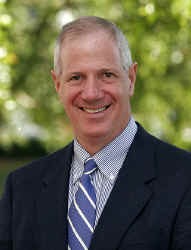 Ross Ungerleider, pediatric cardiothoracic surgeon at Driscoll Children’s Hospital in Corpus Christi, Texas, is ranked in the top one percent of his specialty and has for the past twelve years been listed as one of America’s best doctors. Over the course of his 40-year career, he has repaired the hearts of more than 6,000 children.
Ross Ungerleider, pediatric cardiothoracic surgeon at Driscoll Children’s Hospital in Corpus Christi, Texas, is ranked in the top one percent of his specialty and has for the past twelve years been listed as one of America’s best doctors. Over the course of his 40-year career, he has repaired the hearts of more than 6,000 children.
Ungerleider’s office is a shrine to children with congenital heart defects. Children’s cards and paintings cover the walls, leaving his awards stacked along the baseboards. Textbooks he’s written sit beside a model heart, and a box filled with artificial valves occupies the coffee table.
I ask, “How many heart surgeries are too many?”
He looks me in the eye. “Every single one.”
Ungerleider’s journey began when his mother took him as a child to the Chicago Roosevelt Museum (now the Museum of Science and Industry). There he saw an enormous model of the human heart with patches and valves lowered into it on strings like a complicated marionette.
His fascination was not just scientific. His parents were divorcing, and he was trying to understand the collapse of his family.
“I was amazed by how orderly and precise it all looked,” he says.
For ten-year-old Ross, the model made sense of broken hearts.
Years later, the summer before he left for college at Wesleyan University, his stepfather was killed in a tragic accident. “A divorce is devastating,” he says. “It makes it harder to relate to the people you love because they’re not in the same place and may say awful things about each other. But they’re still there. I understand the permanence of death. I never take lightly the fear of the parents of the children I operate on.”
On the day that his mother drove him to college, they heard a song on the radio — Tony Bennett’s hauntingly beautiful “Who Can I Turn To?” His mother looked into his grieving eyes and said, “I’ll find that record and send it to you.”
On a crisp New England morning a month into his undergraduate studies, he received a call telling him that his mother had unexpectedly died. Stunned and numb, he went home for the funeral. When he returned to campus, “I was walking across the football field, looking at the stars and wondering, what would become of me? How was I going to make it? “
The next morning, he received a package in the mail — “Who Can I Turn To?” Mailing that record had been one of the last things his mother ever did.
Ungerleider now believes that his mother died of Broken Heart Syndrome. Shortly after her death, his English professor read out loud an excerpt from the Yeats poem, “The Circus Animals’ Desertion.” As he read, “I must lie down…in the foul rag and bone shop of the heart,” the professor went to the window, raised it to take a deep breath, and said, “You are all too young to understand.”
But Ungerleider understood.
He graduated from Wesleyan University with a major in English, a thesis in biology, and highest honors. It was 1970. The Vietnam War was raging, and the draft caused a surge in applications to medical school, making admissions far more competitive. Like his peers, he was afraid that his dreams would be shattered. He watched a friend throw a chair at the television when his number was called.
Ungerleider was accepted into medical school on his third attempt, landing at Rush University in Chicago. After medical school, he went into the CT surgery training program at Duke, helping start Duke’s pediatric heart program in 1986. He spent 23 years at Duke, first as a resident and later as faculty. He subsequently worked in Oregon, Ohio, North Carolina, and finally Texas. Through hard work, determination, and trial and error, he became an expert in heart defects with special expertise in aortic valve surgery.
Ungerleider believes that his parents’ divorce, followed by the loss of his stepfather and then his mother while he was still so young, gave him the resilience to withstand failure and the empathy needed to care for patients — probably two of the most important skills needed in medicine today.
As a child in Chicago, Ungerleider had been mesmerized by the soft, incessant “lub, dub,” of the model heart in the museum. And looking back now, he recognizes that the exhibit highlighted major breakthroughs in the management of congenital heart defects. Heart-lung bypass had just become a reality.
But at the time, “I only knew that, if I became one of these surgeons,” he says, “I could fix the broken hearts of other kids.”



